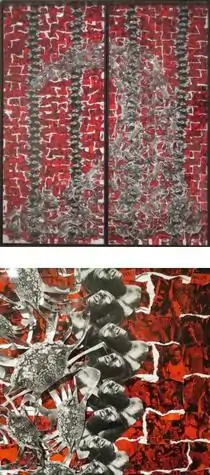Kapulani Landgraf
Kapulani Landgraf (born 1966) is a Kanaka Maoli (native Hawaiian) artist who is best known for her work in black-and-white photography. Through a series of photographic essays, objects, and installations, Landgraf celebrates Native Hawaiian culture while also addressing the legacies of colonialism and its impact on indigenous Hawaiian rights, value and history. While her work often centers on the negative impacts of land use and development, she also alludes to the resilience of the land and the indigenous population. Landgraf says about her work, "Although much of my work laments the violations on the Hawaiian people, land and natural resources, it also offers hope with allusions to the strength and resilience of Hawaiian land and its people.”[1] Landgraf's most recent work combines photographic series with objects and installations.
Kapulani Landgraf | |
|---|---|
| Born | Anne Kapulani Landgraf 1966 Pu'ahu'ola, Kaneohe, Koʻolau Poko, Oʻahu |
| Nationality | American |
| Education | Windward Community College, AA Liberal Arts; University of Hawaii at Manoa, BA in Anthropology; Vermont College, MFA |
| Known for | Photography, collage, mixed-media, installation |
Notable work | Na Wahi Kapu o Maui, 1994; Ponoiwi, 2013; Ē Luku Wale Ē (Devastation Upon Devastation) 2016 |
| Awards | 1999 - En Foco New Works Photography Award. 1996 - State Foundation on Culture & Arts Fellowship, 1995 - Ka Palapala Pu’ukela Award 1994 – Roy Levin – Jessica Lutz Award, Vermont College 1991 – Image XVI “Kodak Eastman Award, Hawaii |

She received a BA in anthropology from the University of Hawaii at Manoa in 1989 and an MFA in Visual Arts from the Vermont College of Fine Arts in 1995.[2] She currently teaches in the Arts and Humanities department at Kapiolani Community College in Honolulu, HI.[3]
In her 1994 book, Nā Wahi Pana O Ko'olau Poko: Legendary Places of Ko'olau Poko, Landraf refutes the tradition of landscape photography of Hawaiian spaces, instead linking place to native Hawaiian ways of knowing and understanding the sacred.[4] In her book, Asian Settler Colonialism From Local Governance to the Habits of Everyday Life in Hawaii, Landgraf describes the history of colonisation in Hawaii, and the effects it has had on the identity of Kanaka Maoli people. Her work is political in nature, emphasizing Hawaiian claims to land and speaks against the continued commodification of the islands by settler groups.[5] Landgraf's work has toured across the United States in the Changing Hands: Art Without Reservation collection. In 2013 Landgraf was awarded the Native Arts and Culture Foundation fellowship. Upon receipt of this award, Landgraf remarked, "The Native Arts and Cultures Artist Fellowship validated artwork created by a Native Hawaiian artist working in Hawai'i on a national scale [...] I hope the national award brings a greater awareness and interest to the realities and injusticies, which continue to occur in Hawai'i and within the Native Hawaiian community. I also hope it inspires and instigates younger Native Hawaiian artists to go beyond the decorative – to give voice and challenge – to push the boundaries – to make people think."[6] During the 2013 NACF Artists fellowship in Visual Arts, Landgraf showcased an artwork that spelled out LANI(sky)."[7]In 2013 the Honolulu Museum of Art exhibited Ponoiwi, a solo exhibition which takes a stand against the decades-long practice of removing sand from Hawaiian beaches, which often desecrates native burial cites.[8] Landgraf is the co-author, with Windward Community College art professor and humanities chair Mark Hamasaki, of Ē Luku Wale Ē (Devastation Upon Devastation), a book published in 2016 documenting through photographs the final stages of construction of the H-3 freeway.[9]
Her photo collage ho 'opa 'a a pa 'a from 2004, in the collection of the Honolulu Museum of Art looks abstract from a distance. However, a close inspection (see image of detail) reveals that it is composed of photographs that relate to the Native Hawaiian people politically, culturally, and historically.[10] The Bishop Museum (Honolulu, Hawaii), the Honolulu Museum of Art, and the Institute of American Indian Arts (Santa Fe, New Mexico) are among the public collections holding work by Kapulani Landgraf.[11]
1999 - En Foco New Works Photography Award.
1996 - State Foundation on Culture & Arts Fellowship,
1995 - Ka Palapala Pu’ukela Award
1994 – Roy Levin – Jessica Lutz Award, Vermont College
1991 – Image XVI “Kodak Eastman Award, Hawaii[12]
References
- "Ponoiwi: An Installation by Kapulani Landgraf". honolulumuseum.org. Retrieved 2017-11-18.
- Kapulani Community College
- "Directory – alandgra | Kapi'olani Community College". www.kapiolani.hawaii.edu. Retrieved 2017-03-04.
- Bacchilega, Cristina (2011). Legendary Hawai'i and the Politics of Place: Tradition, Translation, and Tourism. Philadelphia, PA: University of Pennsylvania Press. p. 29. ISBN 978-0812222500.
- Fujikane (editor), Candace (2008). Asian Settler Colonialism: From Local Governance to the Habits of Everyday Life in Hawaii. Honolulu, HI: University of Hawaii Press. p. 33. ISBN 978-0824833008.CS1 maint: extra text: authors list (link)
- "Native Arts and Cultures Foundation". Archived from the original on 15 April 2014. Retrieved 30 May 2014.
- Totally (2012-12-04). "Kapulani Landgraf". Native Arts and Cultures Foundation. Retrieved 2019-02-08.
- "Honolulu Museum of Art". Retrieved 30 May 2014.
- "Kapulani Landgraf - Native Arts and Cultures Foundation". Native Arts and Cultures Foundation. 2012-12-04. Retrieved 2017-03-04.
- Honolulu Museum of Art, wall label, ho 'opa 'a a pa 'a, accession 28050
- Native Arts and Culture Foundation
- "Kapulani Landgraf - haaedu.org". www.haaedu.org. Retrieved 2019-02-08.